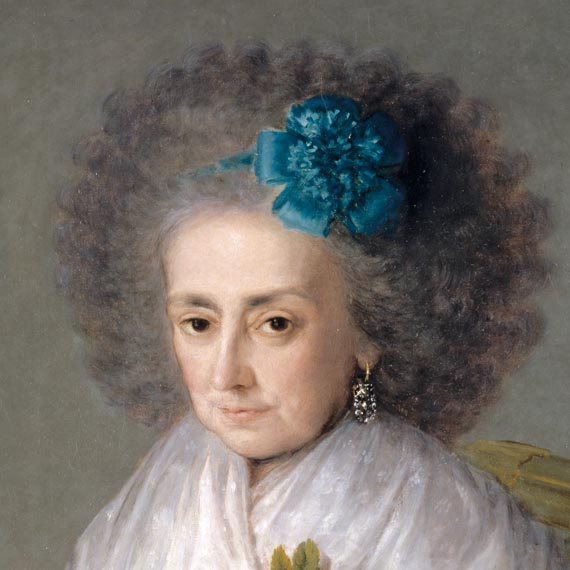

Francisco de Goya’s portrait captures a small woman with a strong character — one can imagine her maintaining decisive control of her family’s fortunes. Her white shawl, ribbons and rose reveal a new softness and delicacy in vogue as fashions now took their lead from France.
‘For this image of the marchioness, Goya has avoided the conventional model of a stately and formal full-length portrait of a lady standing in the midst of her properties. Rather, this threequarter length portrait presents the sitter in an intimate light, seated on an austere, though elegant, chair with a gilt frame in the style of the reign of Charles IV. The refined elegance of her dress is reflective of the French-influenced styles then in fashion and includes elements that were typical feminine adornments at the time, such as the blue silk cockade she wears in her large powdered wig, her rose brooch, and the blue ribbon tied around her white shawl. The play of light on the shawl’s slightly transparent chiffon allows Goya — utilising the devices of Venetian painters like Titian — to highlight the marchioness’s delicate intelligent features and sensitive, reflexive facial expression.’ 1


During the 1700’s the sublime gave way to the delightful, the dignified to the graceful, grandeur of size to the charm of elegance. Along with an increased regard for women — the expression of tenderness and feelings became more important.
Diamonds were by now mined in Brazil and the quantities imported had increased 10 times the amount as in the last years of Indian production. An early form of the brilliant cut had been invented — there was a whole new sparkle to the jewellery trade.
No more heavy gold settings or straight rows of gems — a new lightness permeated. Diamonds were now set in silver to best show off their whiteness — and as the settings became lighter, metal was relegated to a supporting role. These airy designs expressed the new naturalism — stones were set at varying angles rather than face on to the viewer — with the result of even more sparkle as the wearer moved.
Improvements in lighting became widespread and the wealthy now owned daytime and evening jewellery — diamonds became synonymous with glittering ballrooms and sparkling conversation across candelabra laden dinner tables.
Barbara Heath is a Brisbane-based jewellery designer
Endnote
1 You can read more about María Antonia Gonzaga by Manuela Mena Marques in the illustrated exhibition catalogue Portrait of Spain: Masterpieces from the Prado.
Know Brisbane through the Collection / Read more about the Australian Collection / Subscribe to QAGOMA YouTube to go behind-the-scenes
Specially curated for the Queensland Art Gallery by the Museo Nacional del Prado, Madrid, ‘Portrait of Spain: Masterpieces from the Prado’ is the largest and most significant international loan the Prado has ever undertaken, and the first exhibition from their collection to be shown in the Southern Hemisphere / Queensland Art Gallery / 21 July – 4 November 2012
#QAGOMA


Thanks for the information. I like it.